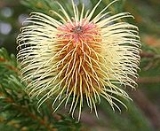
Banksia pulchella
Encyclopedia
The Teasel Banksia is a species of small shrub in the plant
genus
Banksia
. It occurs on the south coast of Western Australia
from Fitzgerald River National Park
east to Israelite Bay
.
It was first collected by Robert Brown
from Lucky Bay
on the south coast of Western Australia in January 1802, and published by him in 1810.
Plant
Plants are living organisms belonging to the kingdom Plantae. Precise definitions of the kingdom vary, but as the term is used here, plants include familiar organisms such as trees, flowers, herbs, bushes, grasses, vines, ferns, mosses, and green algae. The group is also called green plants or...
genus
Genus
In biology, a genus is a low-level taxonomic rank used in the biological classification of living and fossil organisms, which is an example of definition by genus and differentia...
Banksia
Banksia
Banksia is a genus of around 170 species in the plant family Proteaceae. These Australian wildflowers and popular garden plants are easily recognised by their characteristic flower spikes and fruiting "cones" and heads. When it comes to size, banksias range from prostrate woody shrubs to trees up...
. It occurs on the south coast of Western Australia
Western Australia
Western Australia is a state of Australia, occupying the entire western third of the Australian continent. It is bounded by the Indian Ocean to the north and west, the Great Australian Bight and Indian Ocean to the south, the Northern Territory to the north-east and South Australia to the south-east...
from Fitzgerald River National Park
Fitzgerald River National Park
Fitzgerald River National Park is a national park in Western Australia , southeast of Perth, in the Shire of Ravensthorpe and the Shire of Jerramungup....
east to Israelite Bay
Israelite Bay, Western Australia
Israelite Bay is a bay and locality at Location on the south coast of Western Australia - frequently mentioned in Bureau of Meteorology weather reports as a geographical marker - it does not have a climate record....
.
It was first collected by Robert Brown
Robert Brown (botanist)
Robert Brown was a Scottish botanist and palaeobotanist who made important contributions to botany largely through his pioneering use of the microscope...
from Lucky Bay
Lucky Bay
Lucky Bay is a bay located at on the south coast of Western Australia.It received its name from Matthew Flinders, who discovered it in January 1802. Flinders had sailed into the hazardous Archipelago of the Recherche, and found his ship surrounded by islands and rocks with nightfall coming on:...
on the south coast of Western Australia in January 1802, and published by him in 1810.

